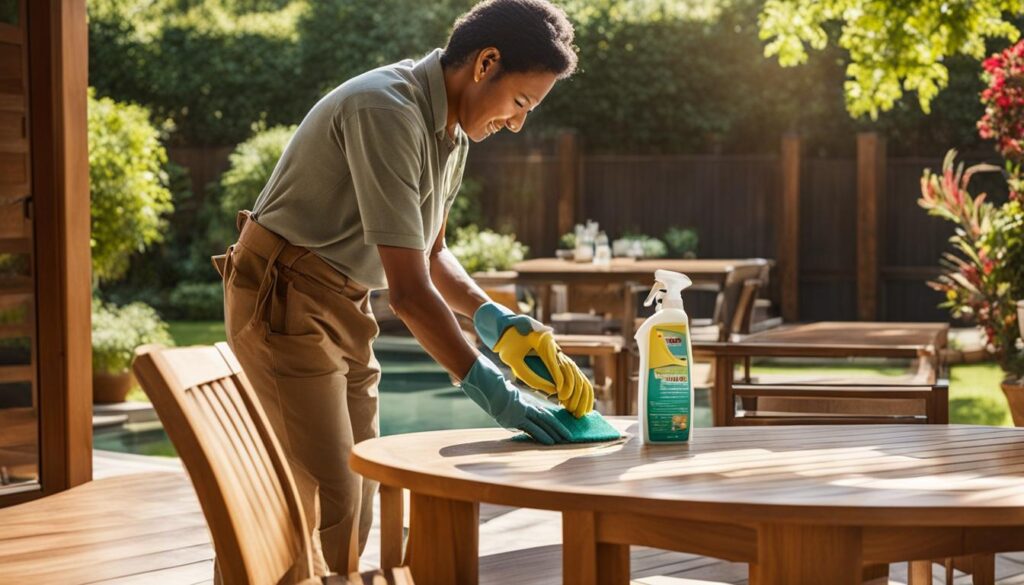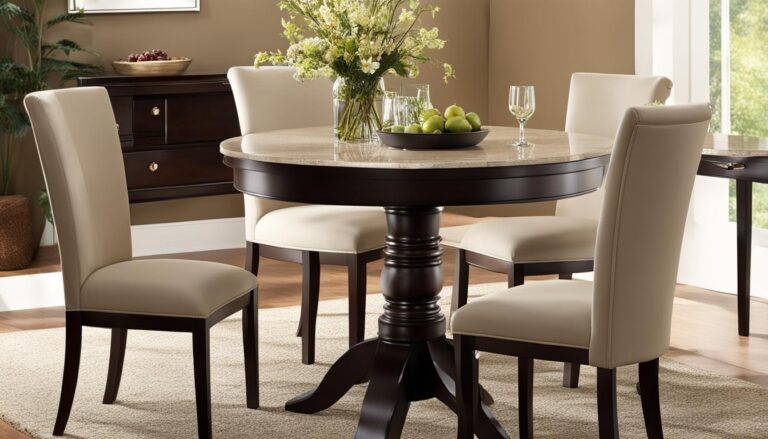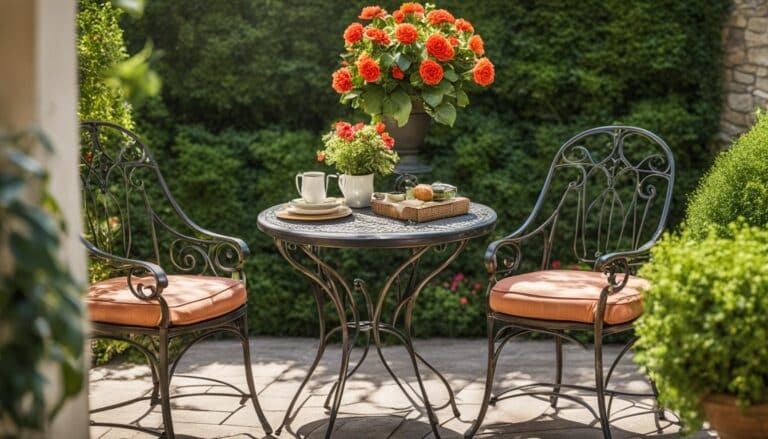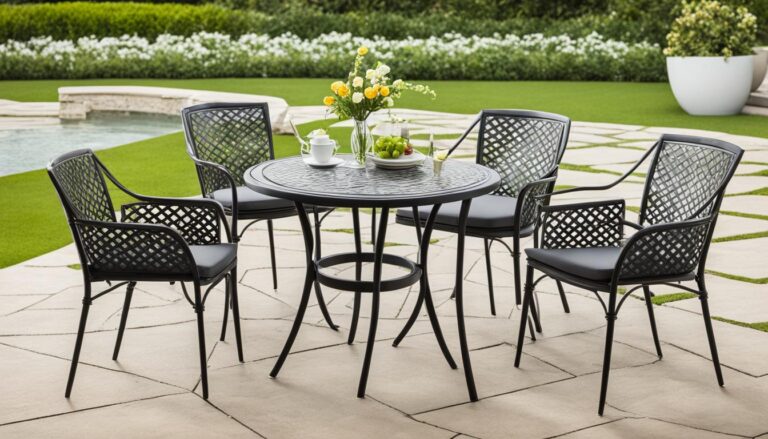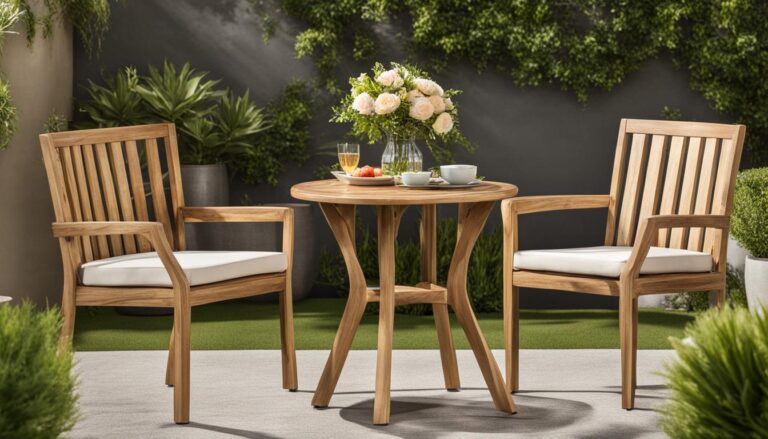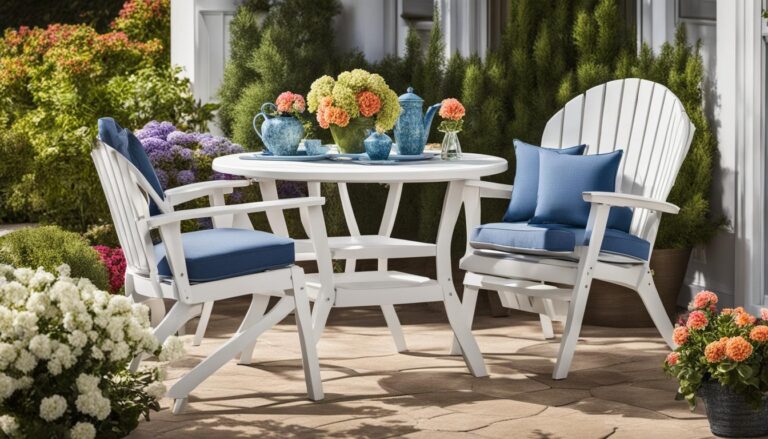Teak patio furniture is a popular choice for outdoor spaces due to its strength, durability, and resistance to weather. To keep your teak furniture looking its best, regular cleaning is essential. In this guide, we will walk you through the easy steps to clean teak patio furniture efficiently, along with some helpful tips for teak furniture maintenance.
Key Takeaways:
- Regular cleaning is necessary to maintain the golden-brown luster of teak patio furniture.
- Teak furniture can change color over time due to aging and exposure to elements.
- Cleaning teak furniture involves using a mild soap and water solution or a teak cleaning product.
- It is important to protect teak furniture from direct sunlight and regularly wipe or rinse off dirt and debris.
- Teak maintenance tactics vary depending on personal preferences and desired aesthetics.
Why Teakwood Changes Color and Weathers Over Time
Teakwood, renowned for its strength and durability, undergoes a natural color transformation over time. Understanding why teak furniture changes color is essential for properly cleaning and maintaining it. The aging process and exposure to elements such as UV rays, wind, and moisture contribute to teakwood’s weathering.
Teakwood changes color due to oxidation caused by prolonged exposure to UV rays. As the wood undergoes this cosmetic transformation, it transitions from a rich golden brown to a beautiful silver-gray hue. Other factors, such as humidity, dampness, and changes in lighting, also play a role in teak weathering.
The weathering process can take several weeks to months, depending on the climate and the level of exposure. It’s important to note that teakwood’s color change does not affect its structural integrity. However, regular cleaning and maintenance are necessary to preserve its natural beauty.
Factors Contributing to Teakwood’s Color Change:
- Exposure to UV rays
- Wind and weather conditions
- Humidity and dampness
- Changes in lighting
By understanding the reasons behind teakwood’s color change, you can implement proper cleaning techniques and maintenance strategies to ensure your teak furniture remains in optimal condition for years to come.
| Factors | Effects on Teakwood |
|---|---|
| UV rays | Causes oxidation and color change |
| Wind and weather conditions | Contribute to overall weathering process |
| Humidity and dampness | Accelerate color change and weathering |
| Changes in lighting | Affects teakwood’s appearance and color |
Basic Steps to Clean Teak Furniture
Cleaning teak furniture is a simple process that involves a few basic steps. To begin, it is important to remove the furniture from direct sunlight and place it in a shaded area. This helps prevent the soap solution from drying too quickly and allows for easier cleaning.
Next, mix a mild soap and water solution in a bucket. You can use a gentle dish soap or a specific teak cleaning product. Dip a soft bristle brush into the solution and gently scrub the wooden surface in the direction of the grain. This helps remove dirt, grime, and stains effectively.
Once you have scrubbed the entire surface, rinse off the soap and residue using a hose or clean water. Make sure to thoroughly rinse all areas, including corners and crevices. This helps ensure that no soap residue remains on the furniture.
It is recommended to clean teak furniture at least once a year, preferably before the fall or in the spring. However, regular wiping or rinsing of the furniture can help prevent the buildup of dirt and debris, prolonging the need for deep cleaning.
Table: Basic Steps to Clean Teak Furniture
| Step | Description |
|---|---|
| Step 1 | Remove the furniture from direct sunlight and place it in a shaded area. |
| Step 2 | Mix a mild soap and water solution in a bucket. |
| Step 3 | Dip a soft bristle brush into the solution and gently scrub the wooden surface. |
| Step 4 | Rinse off the soap and residue using a hose or clean water. |
| Step 5 | Repeat the cleaning process annually or as needed, and regularly wipe or rinse the furniture to prevent dirt buildup. |
By following these basic steps, you can easily clean your teak furniture and maintain its natural beauty. Remember to always use gentle cleaning techniques and avoid harsh chemicals or abrasive materials that can damage the wood’s finish.
Tips for Cleaning Teak Furniture
When it comes to cleaning teak furniture, there are a few tips and tricks that can help ensure that your furniture stays in top condition. Here are some recommendations to keep in mind:
- Wear gloves and eye protection when using teak protectors and sealants to keep yourself safe.
- Before using any cleaning products, it’s always a good idea to test them on a small, inconspicuous area to ensure compatibility with the wood.
- Promptly clean up any spills to prevent staining the teak.
- Using coasters under glasses and hot pads under hot dishes can help prevent water stains and heat damage.
- Sanding should always be done in the direction of the wood grain to maintain a smooth finish.
Avoid using pressure washers on teak furniture as the high-pressure streams of water can damage the wood’s surface. Instead, opt for gentle scrubbing with a soft bristle brush and mild soap and water solution.
When it comes to teak oil, it’s important to note that it should not be used on outdoor furniture. However, teak sealants can be used to enhance the wood’s natural color and provide additional protection against the elements.
| Title | Description |
|---|---|
| Tip 1 | Wear gloves and eye protection when using teak protectors and sealants. |
| Tip 2 | Test cleaning products on a small area of the furniture before applying them to the entire surface. |
| Tip 3 | Clean up spills promptly to prevent staining the teak. |
| Tip 4 | Use coasters under glasses and hot pads under hot dishes to prevent water stains and heat damage. |
| Tip 5 | Sand teak furniture in the direction of the wood grain for a smooth finish. |
By following these tips, you can ensure that your teak furniture stays clean, protected, and looking its best for years to come.
Protecting Teak Furniture from Weathering
Teak furniture is known for its durability and resistance to weather, but it still requires protection to maintain its beauty and longevity. By taking proper precautions, you can prevent weathering and keep your teak furniture looking its best for years to come.
1. Minimize exposure to direct sunlight:
Teak wood naturally weathers to a silver-gray color over time when exposed to UV rays. To slow down this process and preserve the original golden-brown hue of your furniture, place it in shaded areas or use umbrellas to provide additional sun protection.
2. Apply a teak protector:
A teak protector is a special product designed to provide extra UV protection and minimize oxidation. Before applying the protector, ensure that the teak is clean and completely dry. Follow the manufacturer’s instructions for the application and reapplication schedule. This will help maintain the wood’s natural color and prevent weathering.
3. Choose the right location:
When deciding where to place your teak furniture, consider the environmental factors that can contribute to weathering. Avoid areas that are exposed to excessive moisture, such as near pools or sprinkler systems. Additionally, keep the furniture away from sources of heat, as rapid temperature changes can cause the wood to crack or warp.
| Protection Tips | Additional Considerations |
|---|---|
|
|
By implementing these protection measures and following proper cleaning and maintenance routines, you can ensure that your teak furniture remains beautiful and resistant to weathering. Taking care of your teak furniture will not only prolong its lifespan but also enhance your outdoor living space with its timeless elegance.
Removing Mold and Mildew from Teak Furniture
If you notice mold or mildew on your teak furniture, it is important to address the issue promptly to prevent further damage and ensure the health and longevity of your furniture. While teak is naturally resistant to mold due to its water-repelling oils, mold can still grow on the wood’s surface when it latches onto dirt, pollen, and debris. Fortunately, there are effective methods for removing mold and mildew from teak furniture.
One simple solution is to use household products such as bleach or vinegar. To do this, mix equal parts bleach or vinegar with water in a bucket. Then, using a soft brush or cloth, gently scrub the affected area with the solution. Be sure to wear protective gloves and eye gear to avoid any potential harm. After scrubbing, rinse the furniture thoroughly with clean water and allow it to dry completely before using or applying any other treatments.
However, if the mold infestation is severe or extends deep into the wood, it is advisable to seek professional teak maintenance services. They can provide specialized treatments and techniques to safely and effectively remove the mold, ensuring the best possible outcome for your teak furniture.
| Methods | Pros | Cons |
|---|---|---|
| Using household products (bleach or vinegar) | Simple and readily available solution | Potential harm to nearby plants; caution needed |
| Professional teak maintenance services | Specialized treatments and techniques | Costly; may require professional assistance |
Summary:
- Mold and mildew can grow on teak furniture when dirt, pollen, and debris are present.
- Household products like bleach or vinegar can be used for surface mold removal, but caution must be taken to avoid harm to nearby plants.
- If the mold infestation is severe or deep-rooted, it is advisable to seek professional teak maintenance services.
Dealing with Stubborn Stains on Teak Furniture
If you have stubborn stains on your teak furniture, there are effective methods to remove them and restore the wood’s natural beauty. One option is to use mild sandpaper to gently sand away the stains. It is important to sand in the direction of the wood grain and avoid using abrasive materials like steel wool, as they can scratch and damage the furniture’s finish.
When removing stains from teak furniture, it is crucial to avoid pressure washing, as this can create an uneven appearance and damage the wood’s surface. Instead, focus on gentle sanding and restoring the smooth finish of the teakwood. By taking these steps, you can effectively remove stubborn stains and rejuvenate the look of your teak furniture.
Table: Effective Methods to Remove Stubborn Stains from Teak Furniture
| Stain Type | Removal Method |
|---|---|
| Food and beverage stains | Gently sand the stained area with fine sandpaper in the direction of the wood grain. |
| Water stains | Apply a mixture of vinegar and water onto the stained area, then gently sand in the direction of the wood grain. |
| Rust stains | Apply a paste made of baking soda and water onto the stained area, then gently scrub with a soft brush or cloth. |
| Ink or marker stains | Use a mixture of rubbing alcohol and water on a clean cloth to gently rub the stained area. |
By following these stain removal methods and techniques, you can effectively restore the pristine appearance of your teak furniture. Remember to always take care when sanding, use gentle pressure, and work in the direction of the wood grain. With a little effort, your teak furniture will regain its natural beauty and continue to be a stunning addition to your outdoor or indoor space.
Common Mistakes to Avoid When Cleaning Teak Furniture
When it comes to cleaning teak furniture, there are certain mistakes that should be avoided to ensure the longevity and beauty of your pieces. By being aware of these common pitfalls, you can effectively clean your teak furniture without causing any damage. Here are some key mistakes to steer clear of:
- Using teak oil on outdoor furniture: While teak oil can enhance the color of teak, it is not suitable for outdoor furniture. Teak oil can promote the growth of mold and compromise the integrity of the wood. Instead, opt for teak sealants that can protect and enhance the wood’s natural color.
- Using bleach without caution: Bleach can be an effective cleaning agent for removing stains and mold from teak furniture. However, it should be used with caution to avoid damaging nearby plants and wearing proper protective gear.
- Using steel wool for scrubbing: Steel wool may seem like a good choice for tough stains, but it can scratch and tarnish the finish of teak wood. Instead, opt for mild sandpaper and gently sand in the direction of the grain to restore the smooth finish.
- Avoiding pressure washing: While pressure washing may seem like a convenient way to clean teak furniture, it can actually create pits and pitted surfaces. It is best to avoid pressure washing and instead opt for gentle scrubbing and rinsing with a hose.
By avoiding these common mistakes, you can ensure that your teak furniture remains clean and beautiful for years to come. Remember to always follow proper cleaning techniques and use suitable products to protect the wood and maintain its natural allure.
Maintaining Teak Furniture for Long-Term Use
Proper maintenance is key to preserving the beauty and longevity of your teak furniture. By following these maintenance tips, you can ensure that your furniture remains in optimal condition for years to come.
Regular Cleaning
To keep your teak furniture looking its best, it’s important to incorporate regular cleaning into your maintenance routine. Simply dusting and wiping the furniture on a regular basis can help prevent the buildup of dirt and debris. Additionally, you can use a soft bristle brush and a mild soap and water solution to gently scrub the surface of the wood. After cleaning, make sure to rinse off any residue with water.
Protective Measures
Applying UV inhibitors or sealers can offer extra protection to your teak furniture against fading and weathering. These products can enhance the wood’s natural color and prolong its lifespan. It’s also advisable to cover your furniture with breathable, waterproof covers when it’s not in use. This will help prevent dirt and contaminants from accumulating on the surface.
Location Considerations
Choosing the right location for your teak furniture can also contribute to its long-term maintenance. Minimize its exposure to direct sunlight by placing it in shaded areas or using umbrellas. This will help slow down the fading process and preserve the wood’s original appearance. Additionally, avoid placing your teak furniture near heat sources or in excessively humid environments, as these conditions can cause cracking or mold growth.
| Teak Furniture Maintenance Tips |
|---|
| Regularly dust and wipe your teak furniture to prevent dirt buildup. |
| Use a soft bristle brush and a mild soap and water solution for cleaning. |
| Apply UV inhibitors or sealers to protect against fading and weathering. |
| Cover your furniture with breathable, waterproof covers when not in use. |
| Choose a location that minimizes direct sunlight exposure and avoids extreme heat or humidity. |
By following these maintenance tips and taking proper care of your teak furniture, you can enjoy its beauty and durability for many years.
Protecting Teak Furniture Indoors
While cleaning and maintaining outdoor teak furniture is crucial, it’s equally important to protect your indoor teak furniture from potential damage. Mold growth can be a common issue for indoor teak furniture, especially in humid or moist environments. To keep your teak furniture looking its best, follow these tips for cleaning and maintaining indoor teak furniture:
- Regular dusting and wiping: Dust and debris can accumulate on indoor teak furniture, diminishing its appearance over time. Regularly dust the furniture with a soft cloth and wipe it down with a damp cloth to remove any dirt or grime.
- Cleaning with household products: To remove mold from indoor teak furniture, you can use household products like white vinegar or a diluted bleach solution. Apply the solution to the affected areas and gently scrub with a soft brush. Rinse the furniture thoroughly and dry it completely.
- Preventing direct sunlight and spills: Like outdoor teak furniture, indoor teak furniture should be protected from direct sunlight to avoid fading. Additionally, use cloths or mats to prevent spills and moisture from damaging the wood.
By incorporating these cleaning and maintenance practices, you can ensure that your indoor teak furniture remains in excellent condition for years to come. Regular care and attention will help preserve its natural beauty and prolong its lifespan.
| Cleaning Tips for Indoor Teak Furniture | Maintenance Tips for Indoor Teak Furniture |
|---|---|
| Regular dusting and wiping | Preventing direct sunlight and spills |
| Cleaning with household products | Using cloths or mats to protect the wood |
Additional Tips and Considerations for Cleaning Teak Furniture
When it comes to cleaning teak furniture, there are some additional tips and considerations that can help you maintain its beauty and longevity. Here are a few key things to keep in mind:
1. Regular Cleaning Routine
Make cleaning teak furniture a regular part of your maintenance routine. By giving your furniture a gentle cleaning at least once a year, you can prevent the buildup of dirt and debris that can lead to staining and deterioration.
2. Use Breathable, Waterproof Covers
To protect your teak furniture from dirt, bird droppings, and other outdoor elements, consider using breathable, waterproof furniture covers. These covers provide an extra layer of protection and help keep your furniture looking its best for longer.
3. Avoid Placing Furniture in Heated Rooms
If you bring your teak furniture indoors during the winter months, be sure to keep it away from heated rooms. Extreme changes in temperature can cause the wood to expand and contract, leading to cracks and damage. Find a cool, dry place to store your furniture instead.
4. Test Cleaning Products
Before applying any cleaning products or solutions to your teak furniture, always test them on a small, inconspicuous area first. This will help ensure that the product is compatible with your furniture and won’t cause any unwanted damage or discoloration.
| Tips for Cleaning Teak Furniture | Considerations for Teak Furniture Cleaning |
|---|---|
| Regularly clean teak furniture at least once a year. | Test cleaning products on a small area before using. |
| Use breathable, waterproof covers to protect furniture. | Avoid placing furniture in heated rooms to prevent cracking. |
By following these additional tips and considerations, you can ensure that your teak furniture remains beautiful and in optimal condition for years to come.
Conclusion
In conclusion, cleaning teak furniture is crucial for maintaining its beauty and durability. By following the proper cleaning steps and taking precautions, you can ensure that your teak furniture stays in optimal condition for years to come.
Regular maintenance and cleaning routines are essential for both outdoor and indoor teak furniture. Wiping or rinsing off dirt and debris regularly can prevent the buildup of stains and mold. Applying a teak protector and keeping the furniture away from direct sunlight can protect against weathering and fading.
Remember to avoid common mistakes such as using teak oil on outdoor furniture, scrubbing with abrasive materials, and pressure washing. Instead, opt for mild soap and water solutions, gentle scrubbing with a soft bristle brush, and sanding in the direction of the grain when necessary.
By taking care of your teak furniture and incorporating regular cleaning into your maintenance routine, you can enjoy its beauty and longevity for many years to come.
FAQ
How often should teak furniture be cleaned?
Teak furniture should be cleaned annually, preferably before fall or in the spring. Regular wiping or rinsing of the furniture can also help prevent the buildup of dirt and debris.
How can I protect teak furniture from water stains?
To prevent water stains on teak tables, it is recommended to use coasters and wipe up spills promptly.
Can I use teak oil on outdoor teak furniture?
No, teak oil should not be used on outdoor furniture as it can lead to mold growth and compromise the wood’s integrity. Teak sealants can be used to enhance the wood’s natural color.
How can I prevent teak furniture from fading?
To protect teak furniture from fading, it is important to minimize its exposure to direct sunlight by placing it in shaded areas or using umbrellas. Applying a teak protector can also provide extra UV protection and minimize oxidation.
How can I remove mold from teak furniture?
Mold can be removed from teak furniture by using household products such as bleach or vinegar. It is important to wear protective gear and avoid damaging nearby plants.
How can I remove stubborn stains from teak furniture?
Stubborn stains on teak furniture can be removed with mild sandpaper. Scrubbing with abrasive materials like steel wool should be avoided.
What are common mistakes to avoid when cleaning teak furniture?
Common mistakes to avoid when cleaning teak furniture include using teak oil on outdoor furniture, using bleach without proper precautions, and scrubbing with steel wool. Pressure washing should also be avoided as it can damage the wood’s surface.
How can I maintain teak furniture for long-term use?
Regular cleaning, sealing, and protection can help maintain teak furniture’s appearance and longevity. Regular dusting, wiping, and applying UV inhibitors or sealers are recommended.
How should I protect teak furniture indoors?
Indoor teak furniture should be protected from direct sunlight and spills by using cloths or mats. Regular dusting and wiping are also important to prevent dirt and debris buildup.
What are additional tips and considerations for cleaning teak furniture?
Additional tips and considerations for cleaning teak furniture include incorporating regular cleaning into a maintenance routine, using breathable and waterproof furniture covers, and keeping indoor teak furniture away from heated rooms to prevent cracking.

